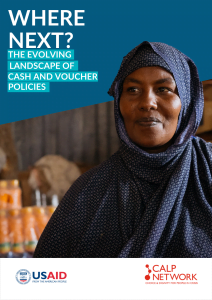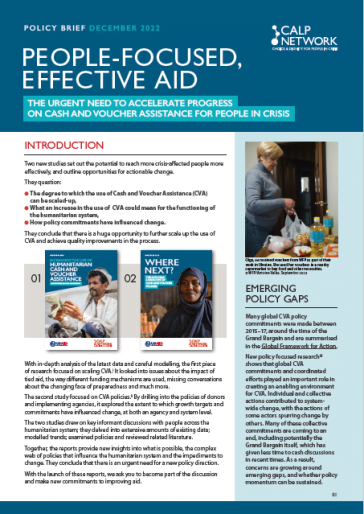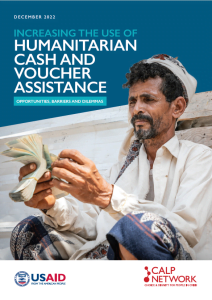People-focused, effective aid: The urgent need to accelerate progress on cash and voucher assistance for people in crisis
Introduction
Two new studies set out the potential to reach more crisis-affected people more effectively, and outline opportunities for actionable change.
The question
- The degree to which the use of cash and voucher assistance (CVA) can be scaled-up,
- What an increase in the use of CVA could mean for the functioning of the humanitarian system,
- How policy commitments have influenced change.
They conclude that there is a huge opportunity to further scale up the use of CVA and achieve quality improvements in the process.
With in-depth analysis of the latest data and careful modelling, the first piece of research focused on scaling CVA. It looked into issues about the impact of tied aid, the way different funding mechanisms are used, missing conversations about the changing face of preparedness and much more.
 The second study focused on CVA policies. By drilling into the policies of donors and implementing agencies, it explored the extent to which growth targets and commitments have influenced change, at both an agency and system level.
The second study focused on CVA policies. By drilling into the policies of donors and implementing agencies, it explored the extent to which growth targets and commitments have influenced change, at both an agency and system level.
The two studies drew on key informant discussions with people across the humanitarian system; they delved into extensive amounts of existing data; modelled trends; examined policies and reviewed related literature.
Together, the reports provide new insights into what is possible, the complex web of policies that influence the humanitarian system and the impediments to change. They conclude that there is an urgent need for a new policy direction.
With the launch of these reports, we ask you to become part of the discussion and make new commitments to improving aid.
Emerging policy gaps
Many global CVA policy commitments were made between 2015-17, around the time of the Grand Bargain and are summarised in the Global Framework for Action.
New policy focused research shows that global CVA commitments and coordinated efforts played an important role in creating an enabling environment for CVA. Individual and collective actions contributed to system-wide change, with the actions of some actors spurring change by others. Many of these collective commitments are coming to an end, including potentially the Grand Bargain itself, which has given less time to cash discussions in recent times. As a result, concerns are growing around emerging gaps, and whether policy momentum can be sustained.
Why it matters
Overwhelmingly, people affected by crisis prefer to receive cash or vouchers over in-kind assistance. Evidence also shows that cash and voucher assistance (CVA) is preferable in terms of the positive impacts on the local economy and, in many cases, gains can be achieved in terms of efficiency and effectiveness. This is all known and well established.
The use of CVA has grown substantially over the last six years. It now accounts for approximately 19% of international humanitarian assistance and is an important part of most responses around the world. The increasing use of CVA is one of the most significant changes in the humanitarian system over the last decade.
Despite good progress, there is cause for concern.
The pace of growth in the use of CVA is slowing, yet we are far from levels that would be achieved if CVA is used wherever and whenever appropriate. With humanitarian needs growing and resources under pressure, aid needs to be ever more efficient and needs to respond more effectively to the preferences of people in contexts of crisis. Collective action is needed to accelerate change.
What the evidence says: established facts and new research
The case for cash is made
- People prefer cash: Evidence shows that in most situations, in most parts of the world, people affected by crisis prefer cash to in-kind assistance.
- It’s about effective aid: The evidence shows that cash can meet basic needs and be used to support a wide range of other outcomes. The evidence also underlines the efficiency of CVA both in terms of delivery and the beneficial impacts on local economies.
- The evidence is solid: In recent years, evidence and understanding of how CVA can be used effectively has increased. Significant bodies of evidence exist related to recipient preferences, ways of managing CVA, thematic considerations, costs and so on.
Quantity and quality of CVA: Far from achieving its potential
- The use of cash is growing: CVA has grown as a percentage of international humanitarian assistance from 7.9% in 2015 to 19% in 2021.
- The pace of growth is slowing: The use of CVA continues to grow BUT the pace of change has slowed significantly – dropping from average year on year rates of 27% between 2016 to 2020 to just 3% between 2020 to 2021.
- Cash is currently under-utilised: This new research shows that if CVA was delivered wherever feasible and appropriate, it would make up 30-50% of all international humanitarian assistance.
- The use of cash varies by funding streams: The research found that, for example, some Country-Based Pooled Funds had targets for the use of cash. It also found that funding allocations via CERF (Country Emergency Response Funds) were substantially lower than the global average use of cash in humanitarian response.
- Scale up requires collective effort: The potential growth in the use of CVA will only be realised through multiple actions, by multiple organisations, in multiple places. There is not one simple untapped reservoir to achieve growth nor any simple levers to create change.
- Quality improvements must keep pace: In some areas, improvements in response programming are not keeping pace with evolving good practice. A strong spotlight on issues of quality and effectiveness remains essential.
- Collective efforts will drive better results: Greater harmonisation of approaches is needed to achieve better quality responses – this includes action on interoperability. Many of the issues that need to be addressed are technically feasible but require substantial political-will as they impact interagency relationships and funding flows.
The humanitarian system, limitations, and opportunities
- The system needs to evolve: These new studies show that more in-kind assistance could be delivered as CVA but the humanitarian system itself is limiting progress. Donor restrictions sometimes limit modality choice. For example, if the entire US Title II budget had been shifted to CVA in 2017, the global volume of CVA would have increased from 15% to 21% of international humanitarian assistance. Operational agency decisions also create limitations. For example, pre-positioned stocks can create pressures to use them rather than focusing on people’s preferences. With growing investments in cash preparedness, it should be possible to reduce investments in pre-positioned relief items.
- Increasing the use of CVA means working differently: In some contexts, the greatest potential for increasing the use of CVA comes from stronger links to social protection or from accessing new sources of financing such as from international financial institutions.
- Bridging the humanitarian / development divide: Cash is fostering discussion between humanitarian and development workers: linkages between humanitarian cash and social protection systems are being actively explored; and work on CVA and anticipatory action is starting to evolve.
- Resources need to be increased and used more effectively. With humanitarian needs growing globally, there is need to use existing resources more effectively and, at the same time, increase the level of funding available. While the overall use of CVA should continue to increase globally, careful context-by-context and sector-by-sector analysis is needed to determine the most appropriate mix of CVA and in-kind modalities in any given situation.
- A case for adjusting the humanitarian system:The growing use of cash raises questions about the structure of the humanitarian system in IASC contexts. The IASC-endorsed cash coordination model provides a place for multipurpose cash in the current architecture, though implementation is in its early stages and there are growing pains to be addressed. Cash payments to the same individuals for multiple purposes also raises questions about effectiveness; and linkages with social protection and development financing require new partnerships and collaboration. Alongside this, questions arise about roles and business models as change continues.
- A case for adjusting humanitarian and development financing: As the divide between humanitarian and development cash transfers narrows, questions arise about whether there is need for changes to aid financing to support more effective and efficient ways of working.
- Collective commitments matter: The research on policy commitments shows that global CVA commitments and coordinated efforts played an important role in creating an enabling environment for CVA. Individual and collective actions have contributed to system-wide change with actions taken in one area or by one group having ‘spill-over effects’ for others – thus driving change elsewhere in the system.
Moving forward
With clear evidence that:
- Humanitarian needs are growing
- CVA is usually the preferred way for people affected by crises to receive assistance
- The use of CVA should be a larger proportion of global humanitarian response
- The quality of humanitarian responses overall, including the use of CVA, needs to be strengthened
- Resources could be used more efficiently and effectively
- Strengthening and expanding social protection systems provides a path for ensuring needs are met by governments.
There is urgent need to:
- Define and commit to a new collective vision for the development of CVA.
- Overcome barriers and address strategic dilemmas that exist in relation to the evolution of CVA, including a review of if/how the current structure of the humanitarian system may need to adjust as the use of CVA increases.
As the use of CVA increases, there are major questions and dilemmas to be addressed and important technical issues to be overcome. This will require clarity of direction, collective commitment and concerted political will.
CALP is calling for system-wide dialogue to define new policy commitments to accelerate collective progress towards meeting the needs of more people, more effectively.
Please subscribe to CALP email updates in order to keep abreast of any developments or opportunities to engage.
For full references please see the PDF version of the policy brief.




